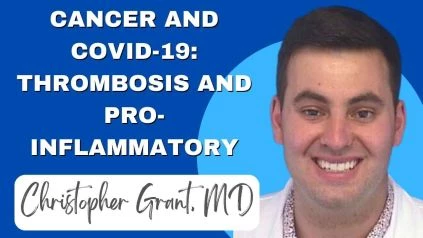Cancer and COVID-19: Thrombosis and Pro-inflammatory (cytokines)
Â
Christopher Grant, MD, MOASC Poster on Cancer and COVID-19: Thrombosis and Pro-inflammatory Cytokines
Hello, my name is Chris Grant. I’m a PGY two at UC Irvine and have an internal medicine residency. And I’d like to present my poster today on thrombosis and pro-inflammatory cytokines responses in COVID-19 with cancer at a tertiary cancer center. And so, just to begin, C is known to have many numerous coagulable factors that actually reach into that pro-inflammatory cytokine state in the OSE triad paired with that cancer also has many of those properties as well.
And so here at UC Irvine, we wanted to correlate and see if there’s a difference between cohorts who have cancer. Cohorts who have COVID and cohorts with both of them to see how their DDIs were elevated and changed. And us utilizing that as a universal inflammatory response marker.
Â
How Long Was This Data’s Timeline?
And so we actually took a look at some of the data of people who ended up developing thrombotic events over the past two years. And what we found is when we placed them into four cohorts, COVID-19 with cancer and a. COVID-19 and cancer without a clot. And then, COVID-19 without cancer with a clot and COVID-19 positive without cancer without a clot and subs were divided and compared and analyzed.
We wanted to be able to determine if there was any changes in factors. And so we ended up having a universal demographic who ended up having it with a variety of cancers, both solid as well as liquid, and then compared their mean D dimers. And we were actually able to analyze and determine between these subsets, if there was any statistically significant difference.
What we ended up finding was that there was not a statistical significant difference between the four cohorts. However, there’s a lot more research that needs to be determined to go through this. For example, Many of the individuals only receive CTE CTAs with a PE protocol due to their high suspicion and actually didn’t get a D dimer really throughout their hospitalization.
And so, further work in analysis to determine what those statistical significances and effects are in some of those confounding variables is warranted.
Â
Christopher Grant, MD – About The Author, Credentials, and Affiliations
Christopher Grant is a PGY-2 Resident at the University of California, Irvine.

